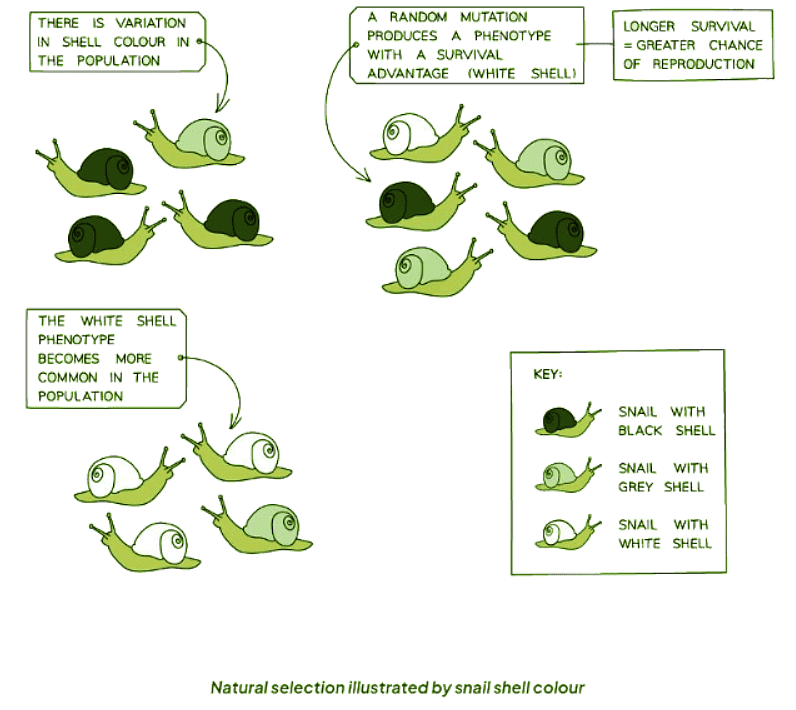Class 10 Exam > Class 10 Notes > Biology for GCSE/IGCSE > Natural Selection
Natural Selection | Biology for GCSE/IGCSE - Class 10 PDF Download
Natural Selection
- In any ecosystem, creatures with advantageous features are more likely to survive and reproduce.
- This process is known as natural selection, where individuals within a species exhibit diverse traits due to genetic disparities.
- When organisms procreate, they produce a surplus of offspring compared to what the environment can sustain, leading to competition for necessities—a 'struggle for existence'.
- Organisms possessing traits well-suited to their surroundings have better chances of survival and reproduction.
- Consequently, the genes responsible for these favorable traits are transmitted to their offspring at a higher rate than genes for less beneficial traits.
- As a result, the succeeding generation will harbor a larger population with well-adapted characteristics.
- This concept of natural selection was proposed by Charles Darwin and is commonly referred to as 'survival of the fittest'.
An example of natural selection:

- Within the snail population, there is variation in shell color.
- The typical shell colors for this species are black or grey, as shown in the first picture.
- Chance mutations result in a few snails or a single snail having a white shell.
- This small number of white-shelled snails is illustrated in the second diagram, where there are fewer white-shelled snails compared to black or grey ones.
- The white-shelled snails have a longer survival rate.
- This demonstrates 'survival of the fittest,' a term describing why some organisms succeed in the struggle for survival against others in their population.
- White-shelled snails survive longer because they are better camouflaged.
- This makes them less likely to be seen and eaten by predators.
- Their longer survival gives them more opportunities to reproduce.
- Consequently, the allele for white shells is passed on to offspring more frequently than the alleles for black or grey shells.
- Over generations, this process repeats, leading to a majority of snails in the population having white shells.

Adaptation by Natural Selection
- If the environment remains constant, the process of natural selection also remains unchanged.
- This situation favors individuals who share similar traits with their parents, ensuring the continuity of those specific characteristics.
- However, if there is a shift in the environment or a random genetic mutation introduces a new allele, natural selection may start favoring individuals with different traits or the newly introduced allele.
- As a result, the surviving individuals will possess a varied set of alleles that they will pass down to their offspring.
- Over successive generations, this genetic variation leads to alterations in the species' traits, ultimately driving evolution forward.
- Evolution is essentially the gradual change in a population's advantageous traits over time due to the influence of natural selection.
- Natural selection drives an ongoing process of adaptation, where features better suited to the environment become more prevalent across generations, facilitating the occurrence of evolution.
Evolutionary Process
- This is how evolution occurs
- This means populations of organisms become better suited to their environment
Evolution is the gradual process by which populations of organisms acquire and pass on new, beneficial traits over generations. This allows them to become more adapted to their environment, increasing their chances of survival and reproduction.
Example: Antibiotic Resistance
- A good example of evolution in action is the development of antibiotic resistance by bacteria.
When bacteria are repeatedly exposed to antibiotics, those that have genetic mutations conferring resistance survive and reproduce, leading to the evolution of a resistant population. This is a clear demonstration of natural selection at work.

Question for Natural SelectionTry yourself: What is the process by which individuals with advantageous traits are more likely to survive and reproduce?View Solution
The document Natural Selection | Biology for GCSE/IGCSE - Class 10 is a part of the Class 10 Course Biology for GCSE/IGCSE.
All you need of Class 10 at this link: Class 10
|
101 videos|193 docs|33 tests
|
Related Searches




















